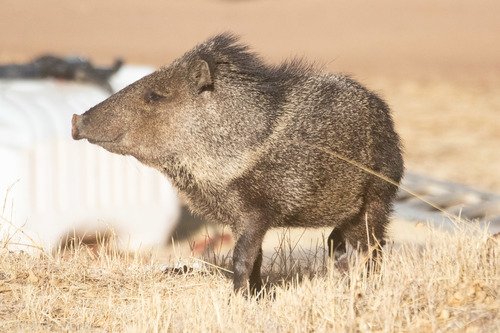
Collared Peccary
The collared peccary (Pecari tajacu) boasts a unique white neck collar and thrives across diverse American landscapes. Known for its social nature, it forms herds and communicates via vocalizations and scent. This adaptable omnivore plays a vital role in seed dispersal and ecosystem balance.
10 years
Lifespan
45562.0 kg
Weight
Dark, Grey
Color
Least Concern
Conservation Status
Stable
Population Trend
Characteristics
Pecari tajacu, commonly known as the collared peccary or javelina, is a medium-sized mammal native to the Americas. It inhabits a wide range of environments, including deserts, rainforests, and grasslands. Notable for its pig-like appearance, it has a distinctive white collar of fur around its neck. Collared peccaries are social animals, often forming herds and communicating through vocalizations and scent markings. Their diet is omnivorous, consisting of fruits, seeds, roots, and small animals.
Distribution Range of the Collared Peccary
Pecari tajacu, commonly known as the collared peccary, is native to the Americas. Its geographical distribution includes parts of North, Central, and South America. This species is found from the southern United States through Mexico and Central America to northern Argentina in South America.
Collared Peccary's Habitat
Environmental Conditions
The collared peccary is highly adaptable and can be found in a variety of habitats. It predominantly inhabits tropical and subtropical regions, thriving in environments such as dry scrublands, deserts, semi-desert areas, and rainforests. The species is also found in grasslands, savannas, and forested areas. The typical climate in these regions ranges from arid to humid conditions, with varying temperatures and precipitation levels.
Ecological Niche
Pecari tajacu occupies a niche as an omnivorous forager. It plays a crucial role in the ecosystem by consuming a wide variety of foods, including fruits, roots, tubers, small vertebrates, and invertebrates, which helps in seed dispersal and controlling insect populations. The species is well-adapted to its environment, with a social structure that often involves living in groups, which aids in protection and foraging efficiency. Collared peccaries are known for their ability to adapt to different ecological conditions, which has allowed them to inhabit a broad range of environments across their extensive range.
Copyright @ Nature Style Limited. All Rights Reserved.
 English
English